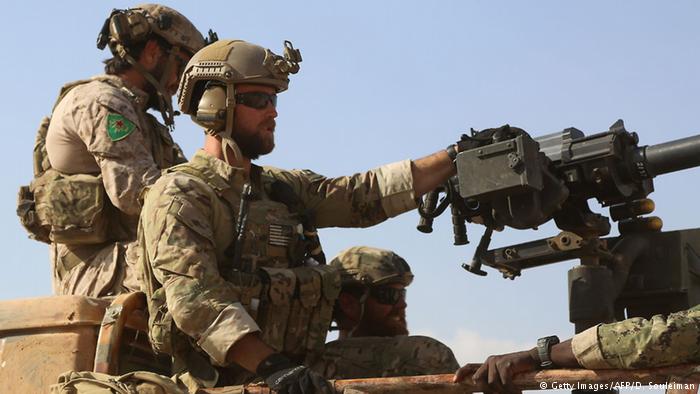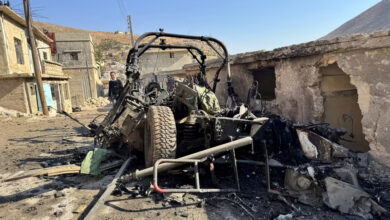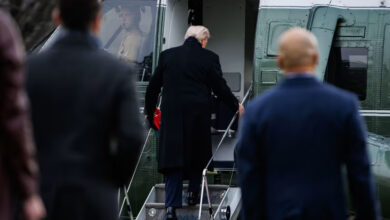
The Trump administration is signaling US plans to keep troops in Syria for the foreseeable future for a mission that extends well beyond the defined goal of defeating the “Islamic State” (IS).
Any mission creep in Syria raises questions about violations of international and American law, as well as the trajectory of the United States’ multi-trillion dollar 17-year global war on terror that has extended to dozens of countries with no end in sight.
President Donald Trump said last week in Davos that “almost 100 percent of the territory once held by these killers in Iraq and Syria” has been retaken, although “there is still more fighting and worked to be done” to consolidate gains against IS.
But the United States is also moving the goal posts of its involvement in Syria, and in doing so raising the stakes of armed conflict with Russia, Syria, Iran, and as events in Afrin recently show, even with NATO ally Turkey.
With IS largely defeated, the US plans to maintain a military force in Syria to counter Iranian influence and ultimately ensure the departure of Syrian President Bashar al-Assad from power through UN-led peace talks, US Secretary of State Rex Tillerson said in a Syria policy speech in January. The US also has humanitarian concerns over displaced persons.
The US dominates the airspace over northeastern Syria and has about 2,000 special forces alongside the Syrian Democratic Forces (SDF), a militia that has led the international coalition’s fight against IS on the ground.
It also has forces supporting anti-IS Arab rebels at a base in al-Tanf, near the border with Iraq. Al-Tanf is close to Iranian and Iran-backed forces, making it “a potential flashpoint” after a number of recent incidents, according to the International Crisis Group.
Unlike Russia and Iran, key backers of the Assad regime, the United States is not in Syria at the invitation of the Syrian government, which accuses Washington of “aggression on Syria’s sovereignty.”
Forever war
Tillerson has justified a continued US military presence in Syria on “ensuring IS cannot re-emerge.”
That is a valid argument, according to Retired Air Force Major General Charles Dunlap, who is now the Executive Director of the Center on Law, Ethics and National Security at Duke University.
“Recent IS losses do not mean that the IS threat is fully extinguished,” he told DW, adding terror groups can morph. “If a military presence is properly justified on a counter-IS rationale, that presence is not somehow rendered unlawful simply because it will also afford the opportunity to obtain other benefits that, alone, might not provide a legal basis for the military presence in the first place.”
But critics say the US strategy looks a lot like the Trump administration is committed to a never-ending war in Syria, with the IS threat simply a cover for a continued military presence.
“The Trump Administration lacks the authority to keep US military forces in Syria after the defeat of IS,” said Democratic Senator Ben Cardin, a ranking member of the Senate Foreign Relations Committee in January. “We are on the precipice of committing US forces to another forever war.”
17-year-old authorization for use of military force
Any mission creep in Syria may renew congressional interest in exerting more control over US forces engaging in hostilities abroad, especially during what is viewed by many as an unpredictable Donald Trump presidency.
Under the US Constitution, war powers are divided between Congress and the president. Congress has the power to declare war and fund military operations, while the president is commander-in-chief.
In 1973, Congress passed the War Powers Act over a veto from President Richard Nixon to clarify and restrict the president’s power to commit the US military to armed conflict.
The law requires that the president notify Congress within 48 hours of US forces being sent into hostilities. The US military must end any combat after 60 days, with a 30-day withdrawal period, without a congressional “authorization for use of military force” (AUMF).
The War Powers Act has long divided Congress primarily between those who view it as a means to restrain the president and those who view it as an unnecessary hurdle in the effective use of the military.
More importantly, the War Powers Act has been repeatedly ignored or skirted around through legal arguments in the past by presidents who view it as an infringement on their authority. But it has also allowed an increasingly dysfunctional and partisan Congress to avoid explicitly taking positions on foreign military interventions.
The Obama administration justified US military action against IS on a broad controversial reading of the 2001 AUMF that justified the war in Afghanistan and against “al-Qaeda, the Taliban, and Associated Forces” — even though IS did not exist at the time of the 2001 AUMF and is a rival of al-Qaeda.
Obama submitted a new AUMF to Congress in 2015, but legislators failed to act.
New AUMF?
The Trump administration has justified continued anti-IS operations in Syria under the same 17-year-old AUMF that the Obama administration used. It has said it has no intention of seeking a new AUMF from Congress.
Meanwhile, the US air force has “undertaken a limited number of strikes against Syrian government and pro-Syrian government forces” to counter threats to US and “partner forces,” according to a December White House letter to congress required under the War Powers Act. Pro-Syrian government forces is a euphemism for Iran-backed Shiite militia.
Dunlap, who held the position as deputy judge advocate general for the US Air Force, suggested that Congress has implicitly supported the US military action in Syria by funding it. But he said Congress should still debate a new AUMF.
“In an era of complex terrorism, the president’s authority to take action to protect Americans and America’s allies ought to be construed broadly. That said, I also believe that a democracy is well served when its elected representatives discuss and debate the wisdom of ongoing military operations, even if not technically required to do so in a particular instance by the Constitution,” he said.




